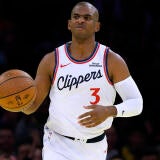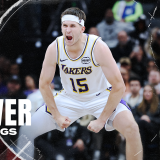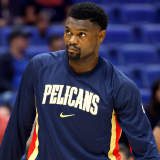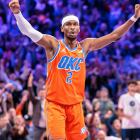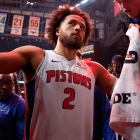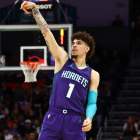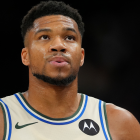How the Warriors could afford Giannis Antetokounmpo in free agency: Two methods to achieve the unthinkable
It would require some incredible cap maneuvering, but the Warriors could theoretically get in the hunt for Giannis in 2021
Doubt the Golden State Warriors at your own risk. Kevin Durant would never sign with a 73-win team, said the masses. He would never join the team that just beat him, and even if he would, it's not as if they could fit him under the salary cap. Real life isn't a video game, the entire basketball world insisted.
We all remember how that one turned out. And now, the NBA's preeminent boogeyman is at it again. What started as whispers several months ago have grown into full-grown rumors. Marc Stein of the New York Times first reported in February that the Golden State Warriors would consider pursuing Giannis Antetokounmpo upon the expiration of his contract in 2021. Ramona Shelburne reaffirmed that notion on Monday's episode of "The Jump" on ESPN.
"The Warriors have always been the big threat to go after Giannis," Shelburne said. "One he's friends with Steph Curry, they have that same agency [Octagon], they know each other. It would be a difficult construction to make happen, but that is the one looming threat."
The Warriors have four All-Stars on their roster and are paying the repeater tax this season, and neither of those things particularly matter. The prevailing lesson of 2019 was that if a team wants to add a superstar, there is little the salary cap can do to stop them. The Warriors were among the greatest examples of that with their acquisition of D'Angelo Russell.
So let's dig into how exactly Golden State could afford their third MVP through either an outright signing or a sign-and-trade. Both methods require complex maneuvering and years of planning. If the Warriors want Antetokounmpo, they need to start preparing for that pursuit now.
Method 1: Signing Giannis outright
The table below shows the 10 players that Golden State has under contract for the 2021-22 season along with their salaries.
Player | Salary |
Stephen Curry | $45,780,966 |
$37,980,720 | |
D'Angelo Russell | $30,013,500 |
$24,026,712 | |
$5,370,370 | |
$3,641,263 | |
$3,588,845 | |
$2,161,440 | |
$1,782,621 | |
$1,782,621 | |
Total | $156,129,058 |
The salary cap for the 2021-22 season is projected to fall at $125 million. Antetokounmpo, as an eight-year veteran, will be eligible for a max contract starting at 30 percent of that total on the open market. The Warriors will therefore need to have $37.5 million in space earmarked for him. Those 10 players alone would bring Golden State more than $31 million above the cap, meaning they would have to shed nearly $70 million to afford Antetokounmpo. What's worse? Those players aren't their only financial obligations. They have the following to contend with as well:
- Shaun Livingston was waived using the stretch provision, so $666,666 in dead money is on their cap as well.
- They own their own 2021 first-round pick, which will cost the Warriors a rookie scale contract unless they trade the pick or stash the player in Europe.
- An incomplete roster charge worth the rookie minimum is assessed to any team with fewer than 12 players on its roster during the offseason. According to RealGM, that will be $1,028,850 during the 2021 offseason.
The projection above does not include that first-round pick, and even if it did, the Warriors would still have to account for one incomplete roster charge and the dead money on Livingston's contract. Fortunately, they have other ways of saving money.
- Smailagic's contract is not guaranteed.
- Evans, Spellman and Poole all have team options as first-round picks in either the third or fourth years of their deals.
- Looney has a player option, which, based on the reaction to his current deal, he is likelier to turn down than pick up.
This is where the first round of cuts can begin. We will assume Looney leaves as a free agent, Smailagic is waived, and Evans, who had a poor rookie season, has his option declined.
Those deals are small potatoes, though. The real question for the Warriors are what they're going to do with their superstars. Two of them have to go, and Golden State wouldn't even have its first choice of which ones. Curry and Thompson combine to make nearly $84 million.
Even if Golden State managed to dump every other player on its roster besides those two, the 10 incomplete roster charges that would come as a result would give the Warriors only around $30 million in cap space, far less than they would need for Giannis. The Rockets encountered this problem in their pursuit of Jimmy Butler. Chris Paul and James Harden were so expensive, that creating max cap space with both was literally impossible.
This would be a devastating loss. If any player is equipped to support Antetokounmpo, it is Thompson. He is arguably the NBA's second-best shooter behind Curry, and as he proved when Durant was on the team, he is happy to play off of the ball as much as necessary.
Thompson would sadly need to be moved for future draft picks in order to fit Antetokounmpo within their cap. The Warriors would then have a choice to make between Green and Russell for their other superstar slot. Russell is younger and a better fit with Antetokounmpo, but Green is cheaper and has a stronger legacy with the team.
The next two years could change things, but for now, we'll assume that Golden State chooses Green and trades Russell for more draft picks. Assuming the Warriors also moved their own 2021 pick, here is what their updated cap table would look like prior to an Antetokounmpo signing:
Stephen Curry | $45,780,966 |
Draymond Green | $24,026,712 |
Omari Spellman | $3,588,845 |
Jordan Poole | $2,161,440 |
Eric Paschall | $1,782,621 |
Shaun Livingston* | $666,666 |
Incomplete Roster Charges x7 | $7,201,950 |
Total | $85,209,200 |
*Dead money
This model would give the Warriors a bit of cap space after signing Antetokounmpo. Once he signed, one of their incomplete roster charges would void and they would be left with around $3.3 million to spend. They could boost that number as high as around $7.8 million if they traded Spellman, Poole and Paschall into someone else's cap space. They would also have the Room Mid-Level Exception, which will fall a bit above $5 million, to add another player.
But the biggest weapon they would have in building out the rest of the team would be trade exceptions. Assuming they deal Thompson and Russell into someone else's cap space without getting any players in return, they would receive two separate trade exceptions, one worth Thompson's salary and one worth Russell's. They could use those exceptions to acquire players in trades who make up to those amounts without sending salary of their own. Assuming they are able to get draft picks back in the Thompson and Russell deals, they would have plenty of firepower to add talent through trades.
The rest of the roster would be filled out with minimum salaries. For veterans, the number to keep in mind is $1,856,061. That is the cost of a two-year veteran. When a team signs a player for the minimum, anything above that two-year figure is covered by the NBA. Older players make more money, but have identical cap charges.
This means little in terms of roster flexibility, as teams can sign minimum players under any circumstance so long as they have the roster space (with one notable exception, which we will get to), but remember that Golden State is paying the repeater tax here. Every dollar counts, so expect to see a mix of those two-year minimums and the cheaper rookie minimums discussed earlier.
If you would prefer to keep Russell instead of Green, the math gets a bit more complicated. He costs nearly $6 million more than Green does, so that money would need to be made up with some of those young players. Trading Spellman and Poole gets them close enough to max space that the difference would be negligible. Antetokounmpo would need to give up less than $3,500 in the first year of his deal to make it work.
Stephen Curry | $45,780,966 |
D'Angelo Russell | $30,013,500 |
Eric Paschall | $1,782,621 |
Shaun Livingston* | $666,666 |
Incomplete Roster Charges x9 | $9,259,650 |
Total | $87,503,403 |
This method sacrifices not only Spellman and Poole, but the extra cap space that the Warriors could have used on another free agent. They would still have the Room Mid-Level Exception, but nothing else besides the minimum to work with in free agency. They would still have trade exceptions from the Thompson and Green deals, but Green's age would likely net less in a trade, meaning the Warriors would have fewer assets to work with in filling out the rest of this depleted roster. Still, Golden State would have options here.
Either way, the basic method is the same. The Warriors would keep Curry and either Russell or Green along with a few young players. They would then need to use exceptions to fill out their roster. The sign-and-trade method, however, is a bit more complex.
Method 2: Acquiring Giannis through a sign-and-trade
We will assume for the sake of ease that Milwaukee agrees to such an arrangement. That is no given, but if the Bucks are faced with losing their MVP for nothing, it is something they would consider. If they cooperate, this path would allow the Warriors to keep Thompson, as they would not be restrained by the cap in such an arrangement. So long as the trade is legal by the CBA's guidelines, the Warriors could make it above the cap.
They would be restrained by another number, however, and it is a far harsher mistress than the cap. Any team that acquires a player in a sign-and-trade agreement is hard-capped at the apron, a figure that fell around $6.3 million above the cap this offseason. The Warriors are dealing with this roadblock now, thanks to the Russell sign-and-trade. For one year after a sign-and-trade is made, the acquiring team cannot go above the apron for any reason.
The projected tax line for the 2021-22 season is currently $151 million. We'll set a projected line of $157.5 million for the apron, which will serve as the number that Golden State cannot exceed in this scenario.
Curry, Thompson and Antetokounmpo alone would cost around $121.3 million. That would give the Warriors around $36.2 million left to spend on 12 remaining roster spots.
Functionally speaking, this means that Green and Russell would both need to be excised in the sign-and-trade. While the Warriors could technically keep Green's $24 million salary and fill out the rest of the roster with nothing but rookie minimum deals, no team would ever actually build a roster with 11 undrafted players, including one starter. That is especially true of Golden State, an organization known to place a heavy emphasis on depth.
Depending on how they structure the sign-and-trade itself, the Warriors could theoretically create a trade exception. Say, for instance, Russell, Spellman and draft picks went to the Bucks. They could then move Green separately into another team's cap space in order to create a trade exception. That exception would not allow the Warriors to exceed the hard cap, but it would give them another method of acquiring talent beneath it.
They would also be able to use the TaxPayer Mid-Level Exception on another free agent worth in the neighborhood of $6.3 million (as projected by HoopsRumors). If they so chose, they could also retain their rights to Looney if he does indeed opt out. Given the multitude of ways that Golden State could allocate all of these resources, projecting an actual roster here would be foolhardy. However, the easiest general roster construction would look like this:
Stephen Curry | $45,780,966 |
Klay Thompson | $37,980,720 |
Giannis Antetokounmpo | $37,500,000 |
Kevon Looney | $10,489,329 |
TaxPayer Mid-Level Exception Free Agent | $6,289,800 |
Jordan Poole | $2,161,440 |
Eric Paschall | $1,782,621 |
Veteran's Minimum Free Agent x8 | $14,848,488 |
| Shaun Livingston* | $666,666 |
Total | $157,500,000 |
It should be noted how rough these projections are. The cap numbers are based entirely on projections. Golden State could choose to prioritize different players, or not to pursue Giannis at all. We are two years out, so virtually any variable in play here could ruin Golden State's plan.
But the gist of it is simple. The Warriors have done this before, and if they so choose, they can do it again.


